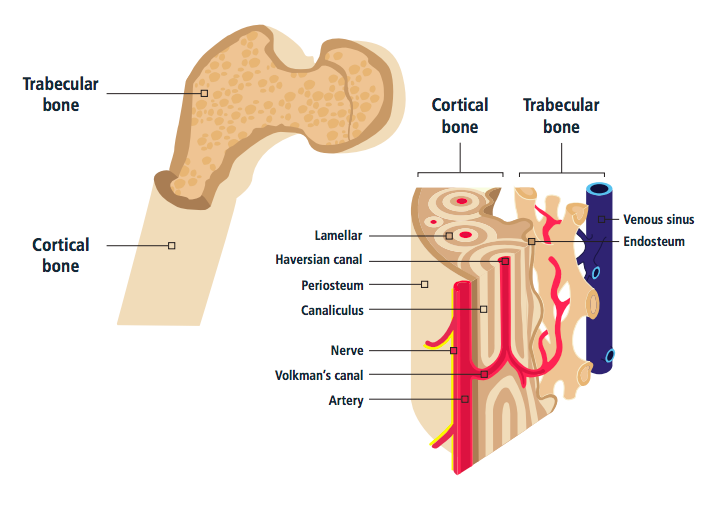When we think of bones, the immediate image that often comes to mind is that of a rigid, unchanging structure. The skeleton, after all, provides our body with shape, support, and protection. However, beneath this external rigidity lies a dynamic, metabolically active system, constantly evolving and renewing itself.
Delving into Bone Anatomy
As illustrated in the image, bones are categorised into two main types:
- Cortical Bone (or Compact Bone): This forms the outer shell of most bones. It’s dense and provides the necessary strength and rigidity.
- Trabecular Bone (or Spongy Bone): Found inside the cortical bone, it looks like a honeycomb and is lighter and less dense.
The image also showcases the intricate internal structure of the bone. Structures such as the Haversian canal, lamellar rings, and canaliculus highlight the organised nature of bone tissues. These canals and microscopic tubes house a network of nerves and blood vessels, emphasising the bone’s active metabolic role.
The Dynamic Nature of Bones
Bones are not stagnant; they are continuously remodelled. This remodelling process involves two main cell types: osteoblasts, which form new bone, and osteoclasts, which break down bone. The balance between these cells’ activities ensures bone health and strength.
Hormones, diet, physical activity, and medications can influence this bone remodelling cycle. For instance, a decrease in estrogen levels during menopause can accelerate bone loss, increasing the risk of osteoporosis.
The Importance of Recognising Bone Metabolism
Recognising the metabolic activity of bones has significant implications for healthcare and personal well-being. Being proactive about bone health means more than just ensuring adequate calcium intake. It’s about understanding the dynamic nature of bones and adjusting lifestyle, diet, and exercise accordingly.
At London Osteoporosis Clinic, the emphasis on proactive bone health resonates with this understanding. The clinic acknowledges the intricacies of bone metabolism, ensuring that individuals receive comprehensive care to maintain and improve their bone health.
Conclusion
In essence, our bones are more than mere structural entities. They are living, breathing, and evolving systems crucial to our health. Let’s shed the myth of bones as static frameworks and embrace the dynamic marvel that they are.

